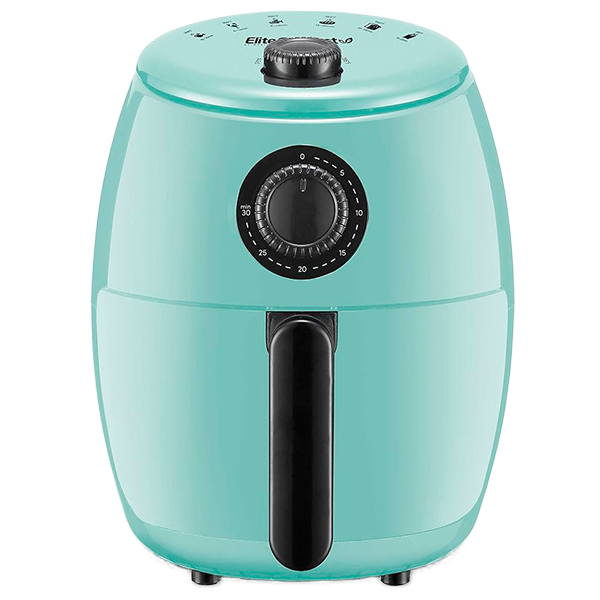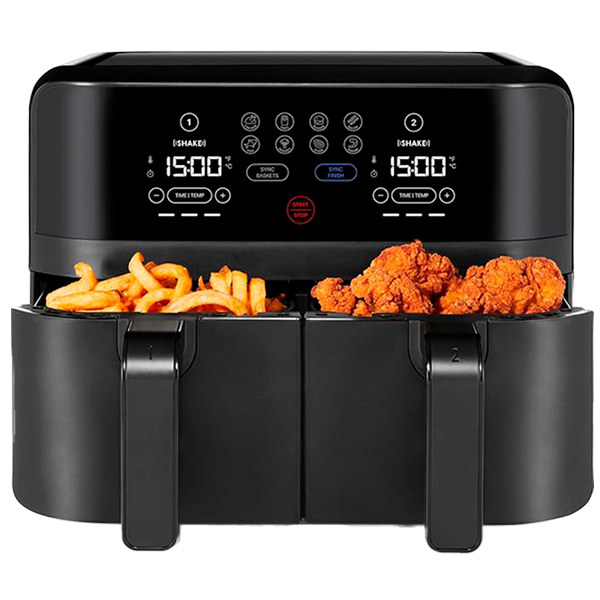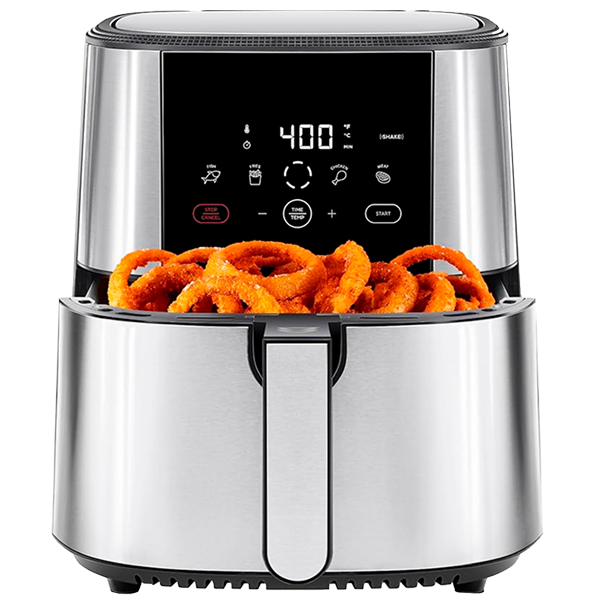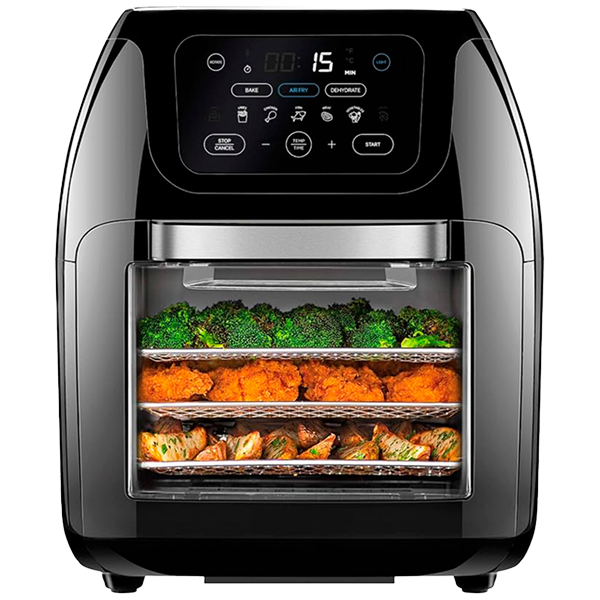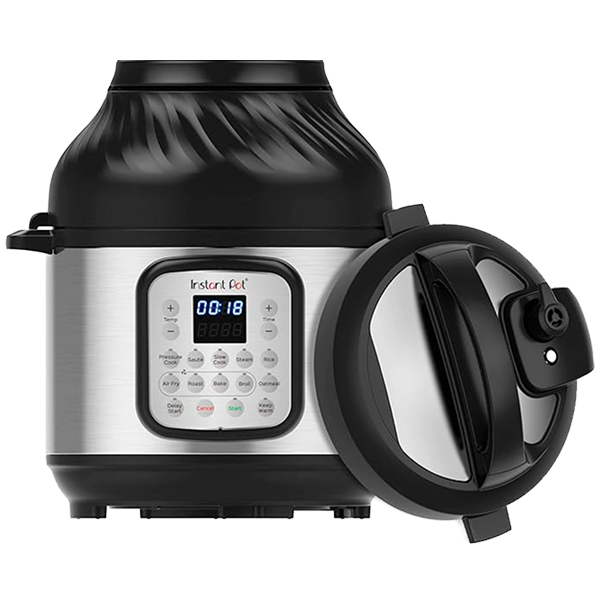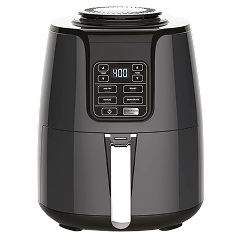Air fryers are already compact compared to most kitchen appliances, but some models take this a step further and are designed for true portability. These are the kinds of air fryers you can take camping, to a tailgate, or even use to cook a meal at home and then carry it with you in the same container.
When looking at this category, it helps to separate compact air fryers from portable air fryers. Compact models are simply scaled-down versions of standard air fryers, made to save counter space but still intended to stay in the kitchen. Portable air fryers, by contrast, are either built with their own off-grid power source (like the Blackstone battery-powered unit) or designed around a container that doubles as a cooking vessel and travel-friendly storage (such as the Ninja Crispi).
Although portable models are still niche, they offer real benefits for people who want flexibility, whether that means preparing food in advance and carrying it with them or having the option to air fry without being tied to a wall outlet.
How To Choose a Portable Air Fryer
Form Factor
Portable air fryers generally fall into two main categories. The first is the glass-container style, with the Ninja Crispi being the most recognizable example. In these designs, the heating element, fan, and controls are built into a lid that attaches to a glass bowl.
The bowl serves as both the cooking vessel and a storage container, often with a secondary airtight lid for carrying food after it has been cooked. This type of design is lightweight and compact, but the glass gets hot while cooking, and long-term durability depends heavily on the quality of the materials.
The second category is the battery-powered style, like the Blackstone Portable Air Fryer. These models are built for outdoor use and often require both batteries and propane to operate. They function much like a traditional basket air fryer, with a pull-out grill basket.
However, they are heavier, bulkier, and more limited in cooking capacity. The upside is that they can be used completely off-grid, which is appealing for camping or tailgating.
Capacity
Capacity is one of the clearest differences between portable models and standard air fryers. Glass-container designs typically max out around four quarts, which is enough to cook for one or two people but not ideal for family meals. Many of these models include two containers—one larger and one smaller—so you can choose based on whether you are making a full meal or just a side dish.
Battery-powered models, on the other hand, tend to hover around three to three and a half quarts, making them similarly suited for smaller portions. For comparison, most standard basket air fryers fall closer to six quarts, so capacity is the first trade-off you’ll notice.
Temperature
Temperature control is another area where portability comes with limitations. Glass-container models usually don’t allow you to set a specific temperature. Instead, they rely on preset cooking modes with fixed ranges.
For example, Ninja’s Crispi presets run between 380 and 450 degrees Fahrenheit (about 194 to 233 degrees Celsius), and some models add a low-heat option for dehydration at roughly 140 degrees Fahrenheit (60 degrees Celsius). This setup makes them simple to use but less flexible if you want precise control.
Battery-powered models do offer adjustable temperature dials, which is more in line with what you’d find on a standard air fryer. The Blackstone, for example, can run between 315 and 490 degrees Fahrenheit (158 to 255 degrees Celsius). However, overall cooking performance is still constrained by power limitations, so you may not get the same even heating or consistency as you would with a kitchen-bound unit.
Time
In a similar vein, you have some limitations with the amount of time these can run. First, anything that’s battery powered is hard limited by its external power. Of course, manufacturers don’t always list how long they can run so you might have to go to forums and reviews to figure that out.
Glass container models have less limitations on time as they just plug into the wall, but since they’re a bit streamlined compared to other types of air fryers (and use a glass container to cook in), they still won’t run as long as something like a toaster oven air fryer. You’ll find that many of these types of air fryers can go for up to 60 minutes.
Controls
As discussed in the temperature section, portable air fryers are pretty paired down. You either have basically just temperature and time controls for the battery powered one or preset modes and time settings for the portable glass ones. That means either no modes or just modes. And you’re generally getting just four or five modes.
Now, the interfaces are the typical buttons with a clear readout to tell you how much time is left, so using them is about as easy as air fryers get. But don’t expect to be able to tweak and adjust the way one can with a typical air fryer. You’ll have to decide if the portability is worth the trade-offs here (and elsewhere).
Build
Build quality varies significantly between the two designs. Glass-container models avoid the common concern of Teflon or PFAS coatings since food is cooked directly in glass. That makes them safer for people worried about chemical exposure.
When shopping, it’s worth checking that the glass is microwave- and dishwasher-safe, as well as rated for high-heat cooking up to at least 450 degrees Fahrenheit. Because the glass bowls get very hot during cooking, well-designed handles and protective features are also important for safe handling.
Battery-powered models lean in the opposite direction: they are heavy-duty, bulky, and often built with metal exteriors that can withstand outdoor conditions. They don’t win on convenience for everyday kitchen use, but they are durable and rugged enough to handle travel.
Extra Features
Unfortunately, portability comes at a cost. And that cost is in extras. These types of air fryers are very straightforward, at least in terms of usage and features. You have limited buttons, limited modes, and sometimes only specific temperature settings. But that’s what happens when you try to make things small.
Really, you could say that their real “feature”, so to speak, is their portability. You could take something like the Blackstone portable air fryer camping and use it to cook if you don’t want to get a fire going. No plugs, no electricity, just some batteries and a small propane tank.
What to Look for
When choosing a portable air fryer, it’s worth focusing on a few specific points. Cooking results vary widely across models, so it helps to look closely at reviews that cover crispiness, cooking speed, and preheat times.
Portability can also be misleading — some units marketed as portable are bulkier than they look in pictures, so check the actual dimensions and weight. For glass-container styles, pay close attention to the quality of the glass.
Cheap versions may crack under heat or sudden temperature changes. Finally, don’t overlook the ease of cleaning. Dishwasher-safe containers and lids make a big difference when you’re trying to pack up quickly after cooking.


